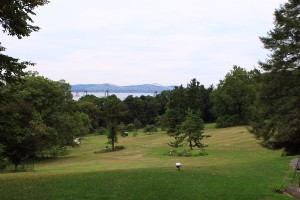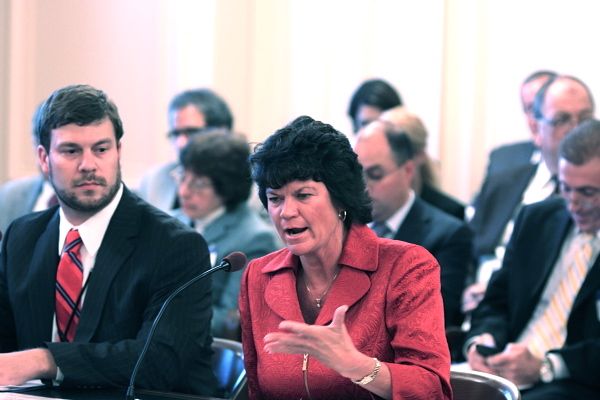Can’t See the Meadow for the Trees
reforesting of meadow at Baldpate Mountain
[Update: 10/27/10 – Surprise, surprise! The Trenton Times put the story on page one above the fold – you read it and decide where quality resides – I’ll try to locate a link. Sorry, link not currently available.]
As I’ve written here before, Mercer County’s Baldpate Mountain is one of my favorite places, especially the magnificent tranquil trails through towering tulip trees! (see this and this for some good photos of the place).
I am a regular visitor there – but it’s not just the forests that inspire.
Meadows may be sub-optimal from an ecological standpoint, but they nonetheless attract.
I examined the source of that attraction as a result of my most recent visit to the mountain last week.
I discovered that a small meadow is being reforested.
It initially did not sit well with me so I spoke to the Mercer County park ecologist who was supervising volunteers. I asked her about the rationale for the reforestation project. I also reached out to a colleague, who provided the following info, which was virtually identical to the response I got from the County staffer, so I’ll post it here:
Friends of Hopewell Valley Open Space and Mercer County are partnering on the reforestation project. In all, a little over 8 acres are being planted with native trees and shrubs. I know the sight of the deer fencing is jarring but, without it, the new plantings wouldn’t stand a chance with the hungry deer.
This field and the smaller one near the orchard are the only ones being reforested. The decision was made after careful consideration of bird habitat needs. We have a substantial body of data on Baldpate’s bird populations and, without a doubt, the forest on Baldpate is its most critical habitat, particularly for forest interior nesting warblers. Since the two fields are not providing critical habitat for grassland birds (too small, wrong configuration) it was decided that the greater good could be served by filling in the gaps and providing even more protection for the forest interior. The fields near the house that provide the views over the river will be left open. There is some talk of planting native meadow grasses and flowers in the lower one, where the septic field is.
The ecological rationale is impeccable – but still, as I continued on in my hike back to Washington Crossing State Park, I was uncomfortable.
I began to wonder why.
As a strong supporter of ecosystem based management, a lover of trees, and scientifically trained to understand the multiple benefits of the restoration project, support of this project should have been a no brainer.
As I walked, I mulled this over. What was really bothering me about it?
I finally concluded that it was a combination of 1) aesthetics, 2) my vision of the larger function of public parks, and 3) nostalgia.
Aesthetically, the fence just spoils the day for me.
But there are other non-visual aesthetic values behind my hatred of fences that have to do with private property rights and control. I am a rambler and just hate fences. Period.
In terms of a larger vision for the Park, the Mercer County staffer correctly noted that Meadow accomodating recreational experiences were provided in other Mercer County Parks.
Her view was that Baldpate’s unique essence was large intact forest. This reforestation project would fill the holes so that 80 years from now, the forest would be unbroken. She saw diversity of Park uses as something to be found within the park system, not necessarily to be found within an individual park.
As an adherent of Fredrick Law Olmsted’s design and functional views on parks as places for people, I just disagree with that view.
[Update – illustration of my point:
Olmsted believed that natural surroundings had a subconscious effect on viewers. The jarring noises and chaotic visual cues of the urban environment produced a tension of the mind, which he contended only nature could undo. Moreover, he felt that the effect was most powerful, not from individual aesthetically pleasing elements (i.e. a rose garden or a pond), but from a totality of design that focused on the composition of wide, sweeping vistas and encompassing scenes that drew the viewer out of his or her own mind and produced feelings of peace and relaxation. As such, his designs avoided hard edges and embraced a constant opening up of new views as the user moved through the space. The Long Meadow is an excellent example of his trademark style: with its undulating hills and scattered trees, the viewer never sees the entire space at once, rather getting a sense of infinite distance with no distractions or boundaries.
and this is good too:
Olmsted brought to this site an organizing concept that separated the farm into three types of spaces: farm, forest and parkland. He also brought design principles learned from his early European travels and mastered in parks such as Prospect Park, Brooklyn. Shelbourne Farm: a (Lancelot “Capability’) Brownian landscape via F.L. Olmsted These design principles, commonly though of as the English naturalistic landscape tradition of the early 18th century are broad meadows with occasional clumping of shade trees, undulating hills, rich and diverse woodlands that transition into these meadows, looping roads strategically through the landscape to alternately reveal and obscure views and the appreciation of an expanse of water to reflect the sky.
So is this excerpt from “A Clearing in the Distance”:
“They submitted a preliminary plan [for Prospect Park in Brooklyn] as well as a report. The report is a remarkable document, not simply a technical description but an extended essay on urban parks. It begins by emphasizing that the purpose of such parks is to provide “the feeling of relief experienced by those entering them. On escaping from the cramped, confined and controlling circumstances of the streets of the town; in other words, a sense of enlarged freedom [emphasis in original] is to all, at all times, the most certain and the most valuable gratification afforded by a park.” Yet parks are more than scenery, the report emphasizes, they are social spaces “for people to come together for the single purpose of enjoyment, unembarrassed by the limitations with which they are surrounded at home, or in the pursuit of their daily avocations, or of such amusements as are elsewhere offered.” Olmsted and Vaux admit that there is a conflict between the desire to create a pastoral landscape to contrast with the urban surroundings, and the need of large numbers of people to enjoy avocations and amusements. The purpose of their plan is to bring these disparate elements into one harmonious whole.
But, I found a far deeper level of resistance that I can only describe as nostalgic.

Lyndhurst, Tarrrytown NY
I grew up in Tarrytown NY, in the shadow of Axe Castle.
I was a rambler at a young age in an historic region known for Hudson River estates, with awesome landscapes (Sunnyside, and Lyndhurst) of meadows, gardens, trees, (Kykuit)…
I regularly enjoyed Rockefeller’s Pocantico Hills property, which is now known as “Rockwood Hall State Park”.
Rockwood’s magnificent meadows are surrounded by thousands of acres of dense forests, in some places punctured by carriage paths and landscaped specimen trees. (Woody Allen’s romantic and visually stunning movie “A Midsummer Night’s Sex Commedy” was filmed there).
Those remote meadows provided countless opportunities for everything from frisbee, to picnics, to youthfull romance, to drunken beer parties and other consciousness raising experiences!
I was deeply saddened by the fact that Mercer County kids would no longer have a place to have those kinds of experiences.
And no 8 acre reforestation can possibly match or be justified by that kind of loss.
view from top of Baldpate – Delaware River looking southeast



